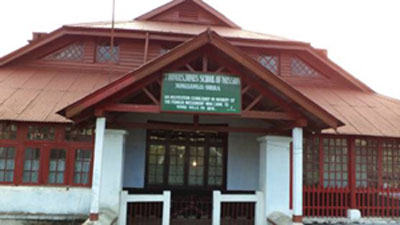
Thomas Jones School of Mission and Evangelism
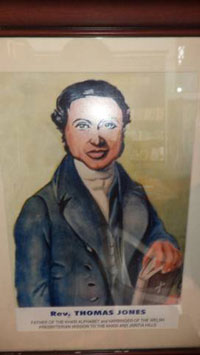 It was on the 22nd June 1841 that Rev. Thomas Jones and his wife, Anne Jones who established the first permanent mission among the Khasis arrived at Sohra and pioneered the Khasi alphabet, literacy and literature. Through out the history, this day has been a red letter day in the history of the Church in Khasi and Jaintia Hills. Thomas Jones taught the Khasis to commercially extract lime by burning limestone with coal; he introduced the saw and other iron tools and improved their agricultural and construction techniques. This pioneer was followed by many other missionaries who bolstered the Welsh contribution to the growth and development of the Khasi-Jaintia people.
It was on the 22nd June 1841 that Rev. Thomas Jones and his wife, Anne Jones who established the first permanent mission among the Khasis arrived at Sohra and pioneered the Khasi alphabet, literacy and literature. Through out the history, this day has been a red letter day in the history of the Church in Khasi and Jaintia Hills. Thomas Jones taught the Khasis to commercially extract lime by burning limestone with coal; he introduced the saw and other iron tools and improved their agricultural and construction techniques. This pioneer was followed by many other missionaries who bolstered the Welsh contribution to the growth and development of the Khasi-Jaintia people.
The Thomas Jones School of Mission previously known as Cherra Theological College, was one among the oldest buildings in the Khasi-Jaintia Hills; it is representative of early 20th Century colonial architecture in Sohra. The claim to being one of the oldest major buildings can easily be sustained because nearly all human-made structures were destroyed by the Great Earthquake of1897. The oldest major building is the neighbouring Nongsawlia Presbyterian Church, which was rebuilt in 1898. Perhaps the next oldest is the main building of the erstwhile Cherra Theological College, which had been founded by Dr. John Roberts in 1887. This structure combined the academic block, the library, the chapel, the hall and the administrative rooms under one roof, for better protection against the extremely damp Sohra climate. Construction work began in the first few years of the 20th Century and church records show that the building was dedicated in 1912, during the annual Assembly of the mission held at Nongsawlia. Here, the identification of this building with the college established by Dr. John Roberts in 1887 must be emphasized, if we are to preserve our sense of institutional history.
The building was constructed under the supervision of Robert Jones, the Second principal of Cherra Theological College and skillful builder. The building's design was carefully planned to combat the rainy, foggy, soggy climate of Sohra; to protect books and documents and people from dampness and fungus. It has a distinctive ultra-high roof that slopes down very low on the veranda all around. The veranda has glass panes fitted on the upper portions to keep out the ever-present fog, while allowing in the sunlight. It has double walls, especially around the library, to absorb the extreme humidity. Although the building materials of stone, lime, hardwood and cane are quite common in the Khasi-Jaintia Hills, the architecture is truly unique. The present buildings of the Thomas Jones School of Mission merit preservation as representative of early 20th century colonial architecture amidst rainy, foggy conditions.




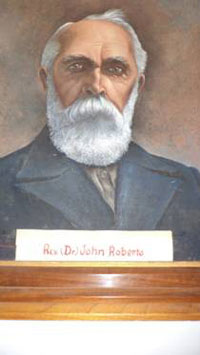 One of these was Dr. John Roberts, widely acknowledged as the greatest of the missionaries, "The appointment of John Roberts at that period was a rare distinction; not only was he counted worthy to take that assignment, but he was found the fittest to head the institution which Christian truths have to be expounded. For starting the centre of learning, he had the grave responsibility of working out the details of administration, the preparation of the curricula, procurement of teachers, working out the financial involvement and other allied matters". He was the founder-Principal of the Cherra Theological College In 1887, the first college in North-East India, and trained most of the early Khasi pastors such as U Khnong Sutnga,U Amirkha,U Sorkin,U Sahon,U Sahon Rai and U Jobin Rai. John Roberts translated much of the Old Testament, composed many hymns including the powerful anthem. "Ri Khasi, Ri Khasi Nga ieit ia pha," co-founded the first Khasi Journal, and wrote so many books and poems that he is honored as the "Father of Khasi Literature".He died on 23 July, 1908, and was buried at the Nongsawlia Presbyterian Cemetery. As Missionary,Preacher,Teacher, writer and translator, his memory and influence will long remain among the people whom he so deeply loved and so faithfully served.
One of these was Dr. John Roberts, widely acknowledged as the greatest of the missionaries, "The appointment of John Roberts at that period was a rare distinction; not only was he counted worthy to take that assignment, but he was found the fittest to head the institution which Christian truths have to be expounded. For starting the centre of learning, he had the grave responsibility of working out the details of administration, the preparation of the curricula, procurement of teachers, working out the financial involvement and other allied matters". He was the founder-Principal of the Cherra Theological College In 1887, the first college in North-East India, and trained most of the early Khasi pastors such as U Khnong Sutnga,U Amirkha,U Sorkin,U Sahon,U Sahon Rai and U Jobin Rai. John Roberts translated much of the Old Testament, composed many hymns including the powerful anthem. "Ri Khasi, Ri Khasi Nga ieit ia pha," co-founded the first Khasi Journal, and wrote so many books and poems that he is honored as the "Father of Khasi Literature".He died on 23 July, 1908, and was buried at the Nongsawlia Presbyterian Cemetery. As Missionary,Preacher,Teacher, writer and translator, his memory and influence will long remain among the people whom he so deeply loved and so faithfully served. 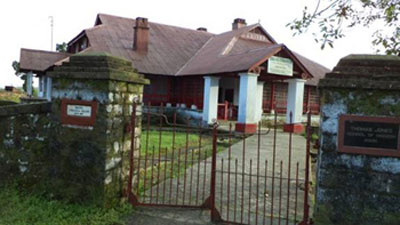 As the years passed the Cherra Theological College, a pioneer institution of its kind in the region, has rendered in valuable services by providing Theological training to church leaders for the ministry of the church. It has expanded and added more structures like hostels, staff quarters and a kitchen-cum-dining hall. In addition to the main academic-library-chapel-administrative building, there are two large bungalows and several smaller houses. These buildings served the Khasis not only in religious instruction but also for educational training. From 1938 till 1983, the Cherra Theological College hosted the ‘Normal School’, where school teachers received training in pedagogical skills. This school moved out to its own premises nearby, on June 1983, and was renamed the Cherra Teachers’ Training Centre.
As the years passed the Cherra Theological College, a pioneer institution of its kind in the region, has rendered in valuable services by providing Theological training to church leaders for the ministry of the church. It has expanded and added more structures like hostels, staff quarters and a kitchen-cum-dining hall. In addition to the main academic-library-chapel-administrative building, there are two large bungalows and several smaller houses. These buildings served the Khasis not only in religious instruction but also for educational training. From 1938 till 1983, the Cherra Theological College hosted the ‘Normal School’, where school teachers received training in pedagogical skills. This school moved out to its own premises nearby, on June 1983, and was renamed the Cherra Teachers’ Training Centre. The Cherra Theological College has trained generations of pastors, not just Khasis but Mizos, Nagas, Kukis, Bodos and many others; and not just Presbyterians but also Baptists, Lutherans, Anglicans, Church of God and various other denominations. It continued to grow and flourish and celebrated its Centenary in 1987. As part of the expansion and academic upgradation of the college, it had to be shifted to Mawklot, near Shillong, in 1994.
The Cherra Theological College has trained generations of pastors, not just Khasis but Mizos, Nagas, Kukis, Bodos and many others; and not just Presbyterians but also Baptists, Lutherans, Anglicans, Church of God and various other denominations. It continued to grow and flourish and celebrated its Centenary in 1987. As part of the expansion and academic upgradation of the college, it had to be shifted to Mawklot, near Shillong, in 1994. 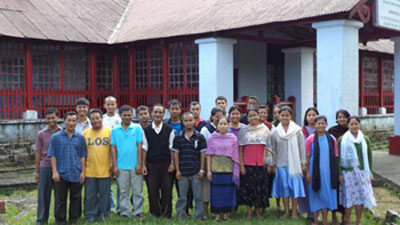 Jones School of Mission was inaugurated on 22 June, 2000, to train the mission workers of the church from different part of Khasi and Jaintia Hills and from the plain areas of Bangladesh as well. It seems quite an appropriate tribute to Thomas Jones and to the Welsh legacy in the Khasi-Jaintia Hills, that we should remember them through this school for Mission workers and Missionaries. Just as their forebears laboured to educate, uplift and develop an entire people, these students too are called to emulate that same spirit. Meanwhile, as a tribute to the strength and vitality of the human spirit the Thomas Jones School of Mission at Sohra continue to stand as a living monument to the vision, the courage, the strong sense of duty, and the determination of an age gone by.
Jones School of Mission was inaugurated on 22 June, 2000, to train the mission workers of the church from different part of Khasi and Jaintia Hills and from the plain areas of Bangladesh as well. It seems quite an appropriate tribute to Thomas Jones and to the Welsh legacy in the Khasi-Jaintia Hills, that we should remember them through this school for Mission workers and Missionaries. Just as their forebears laboured to educate, uplift and develop an entire people, these students too are called to emulate that same spirit. Meanwhile, as a tribute to the strength and vitality of the human spirit the Thomas Jones School of Mission at Sohra continue to stand as a living monument to the vision, the courage, the strong sense of duty, and the determination of an age gone by.